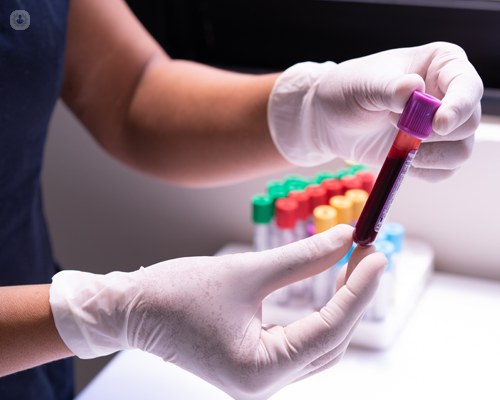Essential thrombocythaemia
Dr Nina Salooja - Haematology
Created on: 11-04-2015
Updated on: 07-11-2023
Edited by: Karolyn Judge
What is essential thrombocythemia?
Essential thrombocythemia, also known as thrombocythemia, idiopathic thrombocytosis, essential thrombocytosis, primary thrombocytosis or haemorrhagic thrombocytosis, is a malignant chronic myeloproliferative disorder or myeloproliferative neoplasm. It is characterised by a bone marrow stem cells (which are responsible for the production of the blood constituents) defect that leads to an uncontrolled production of blood cells of myeloid lineage, which lead to thrombosis and haemorrhages.

What are the symptoms?
In more than half of cases, this condition is asymptomatic, and is coincidentally diagnosed during other routine exams. When they show up, the symptoms are usually associated with circulatory disorders such as:
- ischaemia,
- vascular disorders,
- diffuse pain,
- redness in the limbs,
- eye disorders,
- poor balance,
- syncope,
- thrombosis or;
- haemorrhaging.
How is it diagnosed?
This condition is usually asymptomatic, and it can only be diagnosed by looking at the results of a blood test. These include:
- Complete blood count (CBC);
- Uric acid blood test;
- Ferritin blood test;
- Folic acid;
- Vitamin B12;
Or with the following tests:
- ECG and heart exam;
- Abdominal ultrasound;
- Chest X-ray scan;
- Bone marrow biopsy;
- Bone marrow aspiration.
Is thrombocythemia serious?
Life expectancy isn't shortened by thrombocythemia, in general. However, serious complications as a result of thrombosis can affect vital organs such as the brain or heart. In untreated pregnant patients, there is a risk to survival of the foetus. Treatment is essential for prevention of thrombosis.
What causes it?
Thrombocythemia is caused by a stem cells mutation, originating an increase in platelets production. Platelets are responsible for coagulating a damaged blood vessel, reducing or preventing a haemorrhage. An elevated platelets count can lead to the formation of obstructions within the blood vessels: this is what happens with thrombosis.
How is it treated?
Treatment is advised for people over 60 with a family history of thrombosis or frequent haemorrhages, whose platelet count is over 1,500,000. Even though it's a chronic condition, the outlook for people with thrombocythemia matches up to the general population.
However, you should keep in mind that there are risks associated with vascular complications - specifically, myelofibrosis (10 per cent of cases) and acute leukaemia (4 per cent of thrombocythemia cases). The goal of any treatment thus becomes preventing vascular complications by taking platelet aggregation inhibitors (except for people who have intestinal conditions associated with a haemorrhage risk). You should also eat a healthy and balanced diet and lead a healthy lifestyle.
Which doctor should I talk to?
You should see a haematology specialist, who will have you do all the necessary tests and exams to formulate an accurate diagnosis and choose the best possible treatment.
